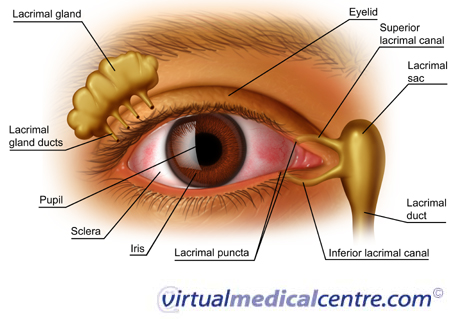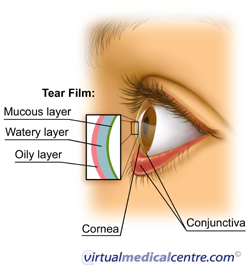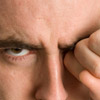- What is dry eye syndrome (keratoconjunctivitis sicca)?
- Statistics
- Risk factors
- Progression
- Symptoms
- Clinical examination
- How is it diagnosed?
- Treatment
- References
What is dry eye syndrome (keratoconjunctivitis sicca)?
Dry eye syndrome occurs when the eye produces fewer or poorer quality tears and is unable to maintain normal eye lubrication. It can also occur when the lacrimal glands are damaged, or when tears evaporate more rapidly than normal.

The medical name for dry eye syndrome is keratoconjunctivitis sicca. Symptoms of dry eye syndrome can include burning, scratchiness or irritation (feeling like there’s something in your eye when there’s not), redness, dryness, blurred vision, and an inability to wear contact lenses. Dry eye syndrome typically occurs in both eyes.
Statistics of dry eye syndrome
Dry eye syndrome is very common. Approximately 20% of the Australian adult population suffer from dry eyes. Research suggests that up to 48% of office workers could experience dry eyes, due to their long exposure to air-conditioning and computer screens. Other groups more likely to report dry eyes include:
- Older adults.
- Post-menopausal and pregnant women.
- Individuals with diabetes or rheumatoid arthritis or autoimmune disorders such as lupus.
- Individuals who take medications such as the contraceptive pill, anti-histamines, tricyclic antidepressants, topical and systemic beta-blockers and topical non-steroidal anti-inflammatory agents.
- Individuals who wear contact lenses.
Risk factors for dry eye syndrome
Dry eye syndrome can be caused or exacerbated by a number of factors, including:
- Normal age-related reduction in the production of tears.
- Hormonal changes – particularly in the production of the female hormone oestrogen.
- Medications.
- Heavily air-conditioned environments.
- Any situation in which blinking is less likely, e.g. when staring at a computer screen, prolonged reading, driving or watching television.
- Windy, dusty, smoky, hot or dry weather conditions.
- Soft contact lenses that absorb tears.
- Eye injury/ burns.
- Fans or hair dryers blowing directly onto the face.
Symptoms of dry eye syndrome

How is dry eye syndrome diagnosed?
Anyone experiencing dry eyes should consult their physician or optometrist.
They are likely to ask about the history of your eyes and do a physical eye examination. You may be asked whether you have had any eye complaints, like foreign body sensation, burning and fear of light.
If the physician suspects dry eye syndrome then they may also test the quality and quantity of your tear production.
Treatment of dry eye syndrome
The main aim of treatment is to control symptoms and eye infections that may result when the eyes are dry or damaged. Mild dry eyes are best managed by using lubricants or artificial tears (in the form of eye drops). These treatment options will not cure dry eye syndrome. However, eye drops can provide temporary relief from symptoms by moisturising and lubricating the eye. Preservative free artificial tears are preferred because preservatives can cause further eye irritation. Other options for mild dry eyes include:
- Increasing blinking.
- Resting the eyes by looking away from computer screens, books or televisions.
- Protecting eyes from sunny, windy environments by wearing sunglasses.
- Avoiding prolonged exposure to smoke or air conditioning.
- Drinking 6 to 8 glasses of water per day to ensure adequate hydration.
- Wearing glasses instead of contact lenses, or wearing customised lenses which do not absorb tears.
More severe instances of dry eyes can be treated using steroids and other medications to reduce inflammation. Other procedures include temporarily or permanently blocking tear ducts to prevent tear drainage.
Kindly created by:
Dr Joe Kosterich MBBS, General Practitioner and member of the Virtual Medical Centre GP Editorial Advisory Board.
More information
 |
For more information on dry eye syndrome, including its symptoms, treatment as well as prevention tips and useful tools, see Dry Eye. |
References
- Dry eyes, menopause and hormone therapy. Australian Family Physician. 2004; 33(11): 930-1.
- Optometrists Association of Australia. Older women at risk of dry eye [online]. Melbourne: Optometrists Association of Australia; 2007 [cited 10 June 2008]. Available from: [URL link]
- Optometrists Association of Australia. Almost half of office workers could be suffering from dry eye, experts [online]. Melbourne: Optometrists Association of Australia; 2007 [cited 10 June 2008]. Available from: [URL link]
- Optometrists Association of Australia. Common medications could cause dry eye: experts [online]. Melbourne: Optometrists Association of Australia; 2007 [cited 10 June 2008]. Available from: [URL link]
- Collier JML, Brown TD (eds). Oxford Handbook of Clinical Specialities (5th edition). New York: Oxford University Press; 1999.
- Isselbacher KJ, Wilson JD, Martin JB, et al (eds). Harrison’s Principles of Internal Medicine: Companion Handbook (13th edition). New York: McGraw-Hill, Inc; 1995.
- Robbins SL, Kumar V (eds). Pathologic Basis of Disease: Pocket Companion (5th edition). Philadelphia: W.B. Saunders Company; 1995.
- Chia E-M, Mitchell P, Rochtchina E, et al. Prevalence and associations of dry eye syndrome in an older population: The Blue Mountains Eye Study. Clinical & Experimental Ophthalmology. 2003; 31(3):229-32.
- Floegel I, Horwath-Winter J, Muellner K, et al. A conservative blepharoplasty may be a means of alleviating dry eye symptoms. Acta Ophthalmologica Scandinavica. 2003; 81(3):230-2.
- Mac Cord Medina F, Silvestre de Castro R, Leite SC, et al. Management of dry eye related to systemic diseases in childhood and longterm follow-up. Acta Ophthalmologica Scandinavica. 2007; 85(7):739-44.
- Lemp MA. Dry eye (keratoconjunctivitis sicca), rheumatoid arthritis, and Sjögren’s syndrome. American Journal of Ophthalmology. 2005; 140(5):898-9.
- Dry eye symptoms in patients and normals. Acta Ophthalmologica Scandinavica. 2000; 78(s231):14-15.
- Dry eye tests. Acta Ophthalmologica Scandinavica. 2000; 78(s231):16-20.
- Whitcher JP. The treatment of dry eyes. Br J Ophthalmol. 2004; 88(5):603-4.
All content and media on the HealthEngine Blog is created and published online for informational purposes only. It is not intended to be a substitute for professional medical advice and should not be relied on as health or personal advice. Always seek the guidance of your doctor or other qualified health professional with any questions you may have regarding your health or a medical condition. Never disregard the advice of a medical professional, or delay in seeking it because of something you have read on this Website. If you think you may have a medical emergency, call your doctor, go to the nearest hospital emergency department, or call the emergency services immediately.







